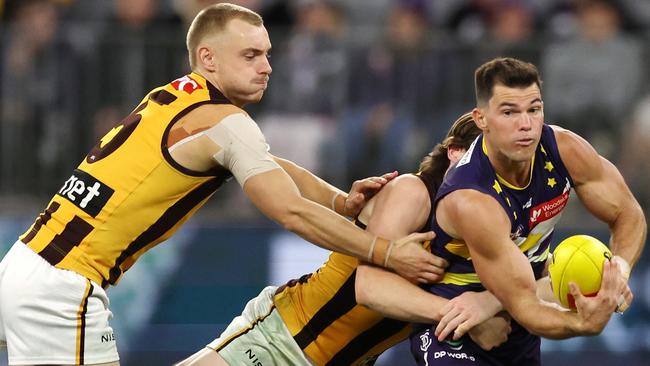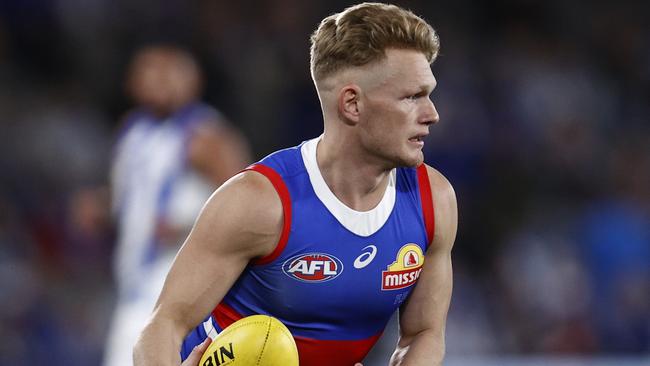AFL Rich 100: Why clubs pay players to play against them and what the future of pick purchasing could look like
It’s hard for fans to understand but makes good list management sense for clubs to pay some of a traded player’s salary. So who are the stars still being paid by their old clubs?
AFL
Don't miss out on the headlines from AFL. Followed categories will be added to My News.
For the clubs who pay hundreds of thousands of dollars for contracted players NOT to play for them, it’s all about the savings.
Call it a glass-half-full philosophy, but in an AFL landscape where salary cap management is absolutely critical, list bosses prefer to think about the upside.
How much did we save in our salary cap instead of waste on a player we once believed in?
Across the competition the practice of paying a portion of your contracted players’ contract at a rival club is becoming increasingly common.
This year there are four high-profile examples.
Hawthorn is paying about $500,000 of the final year of Jaeger O’Meara’s contract as part of a trade that secured them No. 1 ruckman Lloyd Meek.
SCROLL DOWN TO READ THE FULL AFL RICH 100 AND HAVE YOUR SAY ON THE BEST AND WORST DEALS IN THE LEAGUE

The Hawks are also paying about $250,000 of Tom Mitchell’s contract in a deal that secured them Geelong’s former first-round pick Cooper Stephens, yet to debut for Sam Mitchell.
Collingwood is paying around $250,000 of Brodie Grundy’s seven-year $900,000-plus deal, which still has four and a half seasons to run.
And the Pies still have two more years of their commitment to pay $300,000 of Adam Treloar’s $900,000 back-ended deal, which runs through to 2025.
Most of us would believe paying $550,000 for Treloar and Grundy to play elsewhere is insanity.
Collingwood instead looks at it as a saving of $1.2 million on their previous wages (plus Hawthorn paying a quarter of a million for Mitchell), and has used that money to bring in Dan McStay, Billy Frampton, Bobby Hill and Tom Mitchell.
If McStay or Hill can kick three goals in this year’s grand final, who are we to judge where Collingwood allocates its resources?
One current list boss told the Herald Sun clubs often paid a chunk of a departing player’s contract to help increase the quality of a draft pick coming back in return.
“It is definitely becoming more and more common. Clubs are more aware of each other’s cap positions and they are also aware of the value of players. St Kilda paid for Jack Steven to go to Geelong when he had a year on his contract. Gold Coast paid for Peter Wright to go to Essendon,” the list boss said.
“When there is a change of coach or a change of system a player who is highly valued at your club can become surplus to needs. If that player doesn’t fit with your strategy you have a mechanism now to get the player out. The salary cap is just another asset clubs have along with picks. So it could be a player is worth pick 40 in a trade, but if you chuck in $200,000 a year until his contract expires, you might give us pick 30.”

The idea of pick purchasing – a bottom-six club using its spare salary cap room to buy a club in contention’s draft picks without having to involve a player – is now being strongly pushed by AFL clubs.
Hawthorn is one of the clubs keen to get in on the act given they have ample cap space but few high draft picks in this year’s draft.
The theory is simple.
Hawthorn give a club like Collingwood or Melbourne $500,000 of cap space a year over three years and secure a first-round pick in return.
But the AFL has always been underpinned by equalisation measures, no matter how swiftly clubs attempt to circumvent them.
Would the industry accept a Collingwood or Geelong handing over its only first-rounder to secure the $1.5 million in extra salary cap room to buy the free agent who won them the flag?
How would that sit with a competition already uneasy that Geelong could so easily snap up Gold Coast’s pick 7 and Jack Bowes for $1.6 million in cap space it just converted into a four-year, $400,000 per season deal?
The Hawks were one of the clubs who just missed on Bowes’ services, and they might not care how their salary cap is used by a rival as long as they secure an early pick to speed their rebuild.
So clubs will continue to ponder innovative ways to improve their lists while the AFL scrutinises pick purchasing to assess the unintended consequences that will surely flow from such a radical measure.


